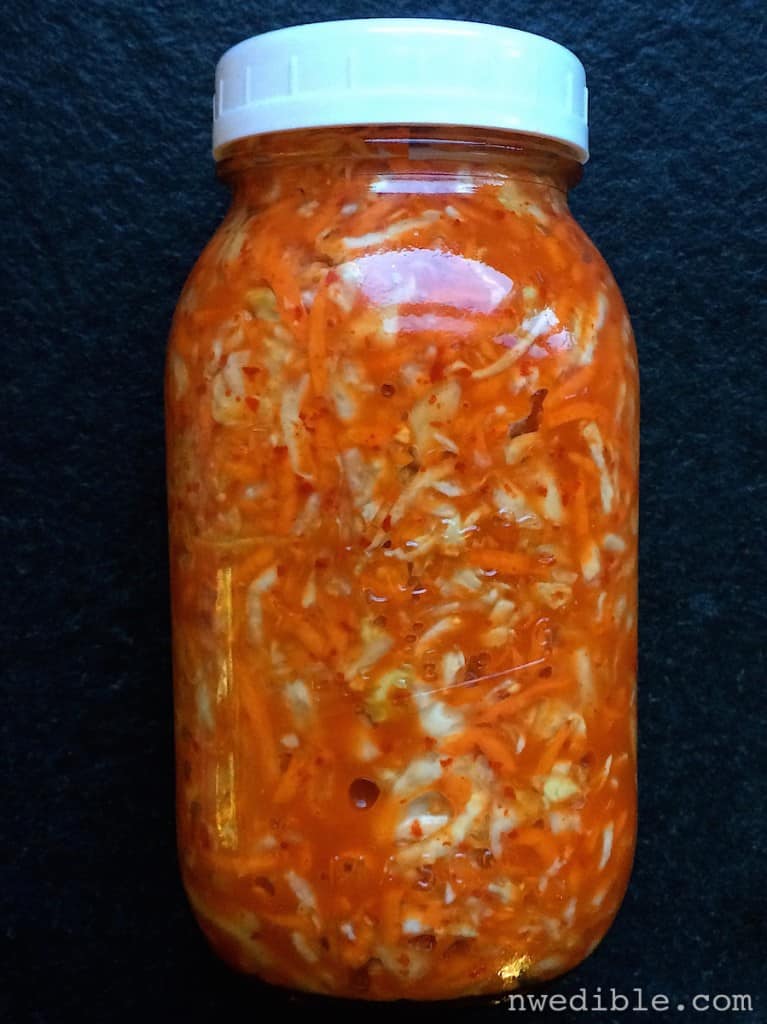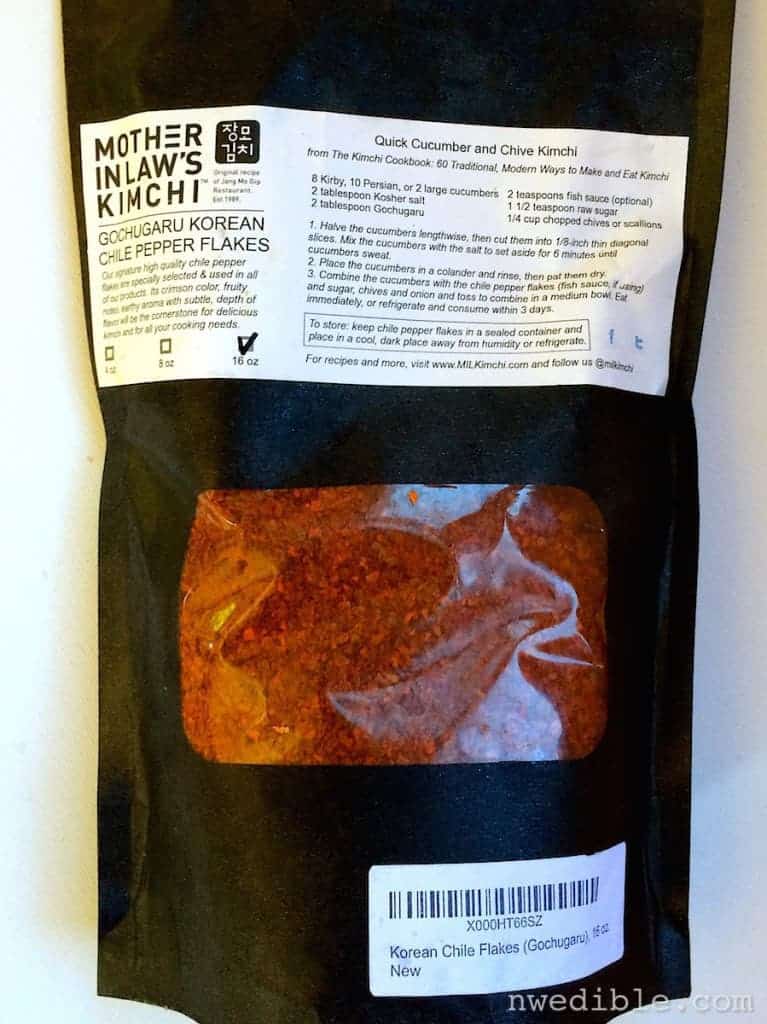Think of this as kimchi for wimps. It’s more accessible in flavor than a traditional Korean, long-fermented pungent cabbage or turnip ferment. But it’s not so unlike kimchi that it won’t stand in well as a spicy, pungent addition to rice bowls, soups, and noodle dishes of all kinds.
For the best results on this ferment, you absolutely need to get a Korean style chili flake called gochugaru. I swear by Mother-in-Law’s Kimchi brand gochugaru. You’ll notice in the recipe below I call for a half-cup of this chili flake.
If you try to substitute regular crushed red pepper flakes at these same quantities, your mouth will melt and drip out of your head like sad, bloody, tongue-colored pudding.
These are the chili pepper flakes I use. If you like Korean food and want that Korean flavor in your ferments, or just want to best tasting sweet-smoky-spicy hot pepper flakes, these are seriously worth seeking out.
If you’ve ever made any kind of sauerkraut, this spicy Korean flavored variation will be familiar. The key components are in this are cabbage, carrot and ginger.
I used what I had – plain green cabbage – but feel free to try this with Napa cabbage, add onion, green onion, or radish and raise or lower the garlic and ginger as you like.
As you no-doubt know by now, fermented kraut variations are infinitely versatile and can be adjusted to your palate.
When it comes time to make this Spicy Korean Kraut, just shred your veggies in the food processor or (if you must) chop by hand. Then salt your kraut and pack it into a perfectly clean crock or jar.
I aim to add 2% salt by weight to this ferment. If you want to adjust the proportions of the recipe (below), just follow this formula to figure how much salt to add:
Weight of Spicy kraut in grams x .02 = Grams of salt to add
After the vegetables in this ferment begin to give off their juices, make sure you pack the kraut firmly into your crock or jar to remove any possible air pockets from the ferment. As I’ve gotten better at fermentation I’ve realized one of the keys to success is to really cram those veggies in there.

Printable Recipe For Spicy Korean Kraut
Spicy Korean Kraut
Prep
Total
An approachable substitute for kimchi, this kraut relies on flavorful Korean chili flakes for it's flavorful kick.
Ingredients
- 1 large cabbage, cored and finely shredded (3 pounds as prepared)
- 8 medium carrots, peeled and grated (1 pound as prepared)
- 8 large garlic cloves, minced
- 1 3"-long piece fresh ginger, peeled and minced
- 1/2 cup Korean style chili flake (gochugaru)
- 40 grams salt (about 2 tablespoons + 2 teaspoon fine sea salt)
Instructions
- Clean and prepare a 1/2 gallon glass jar or fermentation crock for fermenting. Make sure it's scrupulously clean!
- Add the prepared cabbage, carrot, garlic, ginger to a large, non-reactive bowl.
- Sprinkle the Korean chili flakes (gochugaru) and salt over the vegetables
- With clean hands, massage all ingredients together until the vegetables begin to give off moisture, about 3 minutes, and the salt and chili flakes are uniformly distributed.
- Transfer the Spicy Korean Kraut to the clean half-gallon mason jar or crock, pressing down firmly with clean hands as you go to eliminate air pockets in the jar.
- Weight down the ferment. There should be enough juice from the vegetables to rise up and fully cover the solids. If there isn't, add 1 tsp of fine sea salt to a cup of water, then add enough of this brine so that the liquids fully cover the solids.
- Loosely seal the crock or jar, and leave the Spicy Korean Kraut at room temperature out of direct sun, for 3 to 10 days.
- Check the ferment daily. Look for bubbles and other signs of fermentation, burp the lid to release any pent-up carbon dioxide in the jar, and taste the development of the Spicy Korean Kraut with a perfectly clean spoon. If you notice any scum developing on the top of your brine, skim it off promptly.
- When you like the taste of the Spicy Korean Kraut or after 10 days, transfer the ferment to smaller jars for cold storage in the refrigerator, where it will keep for at least 6 months.




This looks just amazing. Thank you so much for sharing.
Thanks for sharing. Will try it this fall.
This looks fascinating, I’d really like to try this. I’m pretty sure with our ethnically diverse community here in Seattle I should be able to find the ingredients.
Nice. I’m nearly to the bottom of my cortido and need to make up a new batch of something. I’ve been on a quasi-ramen soba noodle bowl kick. This would be perfect.
OFF TOPIC….I’m not receiving posts by email anymore. I tried subscribing again but I’m told I’m already subscribed. The posts by email are not going to my spam folder. Any one recognize what I may be doing wrong?
Yes – me too!!
I’ve been doing something like this for 10 years or so. Instead of cabbage I use bok choi because they take a lot less time to grow. In our 180 day growing season I can get 3-4 to four crops of bok choi to one or maybe two of cabbage. Also bok choi is a lot less attractive to cabbage worms. I also throw in grated radishes, or turnips in the early summer, and daikons or carrots in the fall.
I’m so excited to try this!
Great to see this post Erica. I’ve been making something similar for years, mostly adapted from Katz’s Kimchi recipe in Wild Fermentation, but I’m excited to try your method. I’ve worried that grated veggies would pack down so tightly that no brine could get in there for fermentation to happen, but I guess I need to just get over that fear. Maybe by grating I’ll finally get as much moisture out of the veggies as recipes say I should be getting. I use head cabbage, prefer more carrots to cabbage in the ratio (1:2), use a lot of ginger (pretty much whatever I have, often 2oz or more to 2lb cabbage), red pepper flakes, and no garlic. One question: if the jar is loosely covered, why would you need to burp it? I use a canning jar lid, held in place by by the ring but not tight. If I haven’t had to burp it, does that mean it’s too loose? Thanks again!